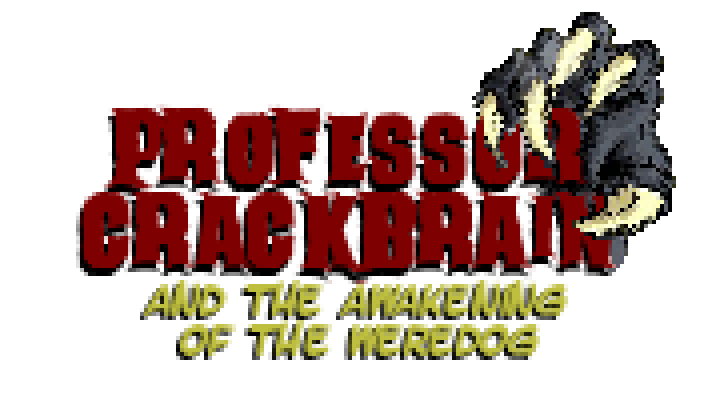Puzzle Dependency Chart
Hi all,
Today I want to give some insights into the design process of the game. Hope someone will find this interesting and useful. This post does not contain direct spoilers for the game, but might give some insights into the game you may don’t want to have, if you plan to explore the game unbiased.
The specific topic I want to cover today is puzzle design. To have interesting, challenging and engaging puzzles is an art of its own. And many games have shown how not to do puzzle design.
I know there are many Point&Click games today, which are very story-driven and do not focus on puzzles as a key element of the game. For Professor Crackbrain this is different. A main objective for development is to bring back the feeling to the player that I had, when I was trying to find the entry to the catacombs in the Library in Indian Jones 3 - The last crusade, getting past the green tentacle in Maniac Mansion or getting the crew together in Curse of Monkey Island.
To create this feeling you need smart puzzles that are fun to solve, that evolve the story and that reward you with progress and animations.
So, how to do this? To find an approach, I had a look at how the world best puzzle designer Ron Gilbert tackles this topic and discovered Puzzle Dependency charts as a tool to keep things focused and aligned.
Here you can see the Puzzle Dependency chart of “Professor Crackbrain”. Zoomed out far enough to not spoiler any puzzles.
I used the Tool “Pencil” to create it. (https://pencil.evolus.vn/ GPLv2 Open Source) It worked very well for this purpose.
On top of the normal Puzzle Dependency Chart connections I have added color coding to document which player of the three main characters has to solve the puzzle, or if you need multiple players to solve it. I also added all Inventory Items as “Ingredients“ to the puzzles. With this setup I felt comfortable to design the game's puzzles. I started the whole process with the final goal of each act and worked my way to the left. With this approach there starts an interesting creative process which lets you combine and connect more and more things here and there.
One challenge here is to find the right moment to end a puzzle chain. An example:
Main Objective: Turn on light
So you need to: 1. find a light bulb and 2. Turn on the light.
Now you can end here and put the bulb in a cupboard and a switch on the wall.
Or you put another main switch in a fuse box in the cellar which is locked.
To open the fuse box you need a key.
You can put it somewhere, or place another puzzle to find the key, …
So you could go on forever, and bore your players to death.
To avoid this endless puzzle after puzzle lines, It’s also important to consider different types of puzzles.
I have collected the following:
- Dialog Puzzles (e.g. Castle Brunwald in Indiana Jones has many of them)
- Inventory Puzzles / Reverse Engineer (or Combine)
- Lock & Key Puzzles
- Environment Puzzles (Directly on the screen)
- Diversion Puzzle (Maniac Mansion ring the bell to distract)
- Timing Puzzle (Wait for the right moment like the chef in Monkey Island 1)
- Mini Games
- Team Work Puzzles (Player A press gargoyle, Player B can go through the open door)
- Did I miss some puzzle types? Let me know.
For sake of completeness I want to mention that I have done an “Ideas” and “Rooms” list in parallel using Trello, to ensure all Ideas get a fair chance to be considered in the game. Once I had a good understanding of the Rooms & Scenes I made a Room Dependency chart showing which scene has an exit to which scene, etc.
What is still really strange, that I do not have any feeling how long the overall gameplay will be in the end. Even with the puzzles in place, It’s hard to judge.
-
Kai
Get Professor Crackbrain - and the awakening of the weredog
Professor Crackbrain - and the awakening of the weredog
Classic Pixel Art Point & Click Adventure
| Status | Released |
| Author | Pixel Monster Games |
| Genre | Adventure |
| Tags | 2D, classic-adventure, Funny, mad-scientist, mansion, Pixel Art, Point & Click, rescue |
| Languages | German, English |
| Accessibility | Subtitles |
More posts
- Update v6.2Dec 19, 2022
- Update 6.1Dec 05, 2022
- Game Release!Dec 02, 2022
- Release on 2nd of DecemberNov 18, 2022
- New Demo released!Nov 05, 2022
- The game is Feature CompleteOct 27, 2022
- New fast travel optionApr 27, 2022
- V 4.0 Demo releaseApr 03, 2022
- New Demo Update (V3.5)Jan 25, 2022
- Does this goat look familiar?Nov 30, 2021

Leave a comment
Log in with itch.io to leave a comment.